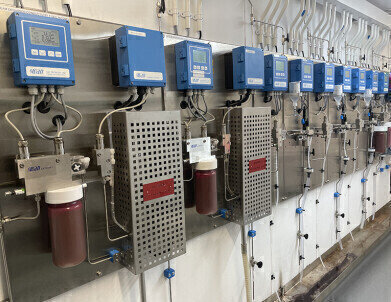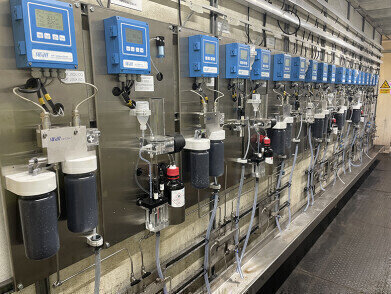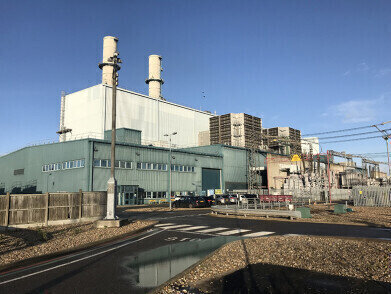-
 Swan instrumentation monitoring Water Steam Cycles at VPI Shoreham
Swan instrumentation monitoring Water Steam Cycles at VPI Shoreham -
 Swan instrumentation monitoring Water Steam Cycles at VPI Immingham
Swan instrumentation monitoring Water Steam Cycles at VPI Immingham -
 VPI Damhead
VPI Damhead
Water Quality Monitoring
Instrumentation confidence underpins power station performance
Feb 13 2024
Steam and water quality analysis performs a critical role in the protection of power plants from corrosion and deposition in the water steam cycle. This is because very small changes in water and steam quality have the potential to impact the performance of the entire power station and cause hugely expensive outages. The cost of monitoring equipment is therefore negligible in comparison with the potential costs of failure to manage water and steam quality effectively, so power plant chemists are constantly seeking accuracy and reliability in their instrumentation.
“Our main driver is to always ensure good feedwater quality, free from corrosive species,” explains power station chemist Adrian Bailey from VPI. “To achieve that goal, we need instruments that can deliver the highest performance levels continuously 24/7, 365 days of the year. For that reason, having tried most of the monitors on the market, we have gradually migrated almost all the water quality monitors at our five UK locations to Swan Analytical Instruments.”
In addition to risk reduction, water quality monitoring also enhances process efficiency, protects plant longevity and availability, and helps ensure compliance with environmental permits.
Background
Various forms of corrosion can affect the metallic surfaces within the internal components of power plants. Corrosion is an electrochemical process, and any build-up of dissolved contaminants such as chlorides, sulphates or other detrimental species could strongly enhance the risk of corrosion such as pitting, flow accelerated corrosion and stress corrosion cracking. This risk is amplified where high temperatures accelerate the corrosion process. Low pH-values in combination with turbulent flow conditions can cause flow-accelerated corrosion (FAC), which is known to be very fast, destructive, and continues to be one of the main root causes of boiler tube failures. Power plant water steam cycle chemistry is therefore focused on minimizing corrosion rates as much as possible, as well as avoiding specific forms of corrosion such as FAC. Mitigating plant corrosion is primarily achieved by continuously monitoring specific conductivity, as well as conductivity after cation exchange (CACE), degassed CACE, pH, dissolved oxygen and where required silica and sodium analysis.
Water quality monitoring at VPI power stations
VPI is one of the leading Combined Cycle Gas Turbine (CCGT) operators in the UK, with assets capable of generating 3.3GW of power; sufficient for around 3 million homes. The company is committed to being part of the UK’s pathway to Net Zero, and in the short-term this means investing in its existing plant to protect the reliability of the UK’s power supply during turbulent times in the energy sector.
Adrian Bailey says: “The efficient operation of our existing portfolio represents a significant challenge because most power stations were designed to operate continuously, rather than the stop-start regime that is required by today’s rapidly fluctuating supply and demand energy market; a situation which can increase potential corrosion risks.”
VPI’s UK locations include Damhead Creek in Kent, Shoreham in West Sussex, Blackburn in Lancashire, Rye House in Hertfordshire, and Immingham in Lincolnshire.
In order to minimise corrosion, all of VPI’s plants dose condensate/feedwater with ammonia or amine blends to establish a specific alkaline pH. However, these alkalising agents could potentially mask the presence of low-level contaminants, so in addition to continuous measurements of pH and specific conductivity, VPI’s plants also monitor underlying conductivity with Swan’s AMI CACE, ‘Conductivity after Cation Exchange’ (CACE) instrument, which removes the ammonia from samples and changes contaminants into their acid form to amplify their conductivity, and thereby enable early detection.
Dissolved gases, such as carbon dioxide, can also mask the presence of low-level contaminants by contributing to the CACE value. The VPI plants therefore also use Swan instruments to monitor degassed CACE continuously. Differential analysis of CACE and degassed CACE indicate whether an elevated cation conductivity value is due to the presence of carbon dioxide or more corrosive ions such as chloride and sulphate.
In addition to conductivity and pH, VPI also employs Swan analysers to monitor trace amounts of dissolved oxygen, silica, and sodium, as well as turbidity which is used for trend monitoring for particulate corrosion products.
Why Swan Analytical instruments?
Swan conductivity and pH analysers were first installed at Rye House power station around 2007, and the first Swan silica analyser was installed at Damhead around 2009. “At that time, there was no common policy for instrumentation, and each power station was running different analysers,” comments Adrian Bailey. “This meant that service and maintenance procedures varied considerably, and the availability of spares and consumables was more complicated. However, the early Swan analysers performed extremely well, so we have gradually migrated almost all of our instruments, at all of the sites, to Swan.”
Explaining the decision to adopt Swan as their preferred instrumentation supplier, Adrian says: “The most important feature of an instrument is the confidence that it inspires in its operators, and this is where Swan led the field. We routinely take grab samples for laboratory analysis to check the accuracy and reliability of the monitors, and this data clearly demonstrated the superiority of the Swan instruments and gave us the confidence to roll them out more widely.
“The amount of time spent on instrument maintenance is also a key issue, and one in which Swan excels. With high levels of reliability and low maintenance requirements, we have found their instruments to be simple to operate; the menus are easy to follow, without the necessity to memorise the manual, which means that the requirement for operator training is minimal.
“Occasionally, we need to utilise Swan’s technical support, and again we have found this to be exemplary; their staff are highly experienced and knowledgeable, so they are able to respond quickly to our requests.”
Summarising, Swan Power Product Specialist, Chris Mead says: “Obviously, we are very pleased that the performance of the Swan instrumentation has provided VPI with the confidence to use them almost exclusively across their facilities. This has helped them to future-proof their plants as they help the UK on its path to Net-Zero.
“The recent installations at Shoreham, Damhead and Immingham are great examples of the benefits that can be gained from installing a complete instrumentation package from Swan. Our monitors are factory-calibrated and pre-mounted on sample panels, making them easier to install and integrate, and with a single source of low-maintenance instruments the cost of ownership is significantly lower.
“However, the costs associated with the purchase and operation of Swan instruments is negligible in comparison with the potential cost implications of plant failure or asset downtime, so we believe that whilst we supplyinstruments, what we deliver is peace of mind.”
Digital Edition
AET 28.2 April/May 2024
May 2024
Business News - Teledyne Marine expands with the acquisition of Valeport - Signal partners with gas analysis experts in Korea Air Monitoring - Continuous Fine Particulate Emission Monitor...
View all digital editions
Events
Jul 30 2024 Jakarta, Indonesia
China Energy Summit & Exhibition
Jul 31 2024 Beijing, China
2024 Beijing International Coal & Mining Exhibition
Aug 07 2024 Beijing, China
IWA World Water Congress & Exhibition
Aug 11 2024 Toronto, Canada
Aug 25 2024 Stockholm, Sweden and online








.jpg)








